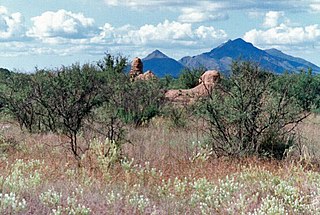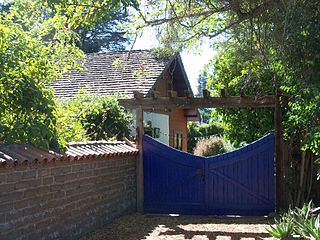
Mission San Xavier del Bac is a historic Spanish Catholic mission located about 10 miles (16 km) south of downtown Tucson, Arizona, on the Tohono O'odham Nation San Xavier Indian Reservation. The mission was founded in 1692 by Padre Eusebio Kino in the center of a centuries-old settlement of the Sobaipuri O'odham, a branch of the Akimel or River O'odham located along the banks of the Santa Cruz River. The mission was named for Francis Xavier, a Christian missionary and co-founder of the Society of Jesus in Europe. The original church was built to the north of the present Franciscan church. This northern church or churches served the mission until it was razed during an Apache raid in 1770.

San Felipe de Neri Church is a historic Catholic church located on the north side of Old Town Plaza in Albuquerque, New Mexico. Built in 1793, it is one of the oldest surviving buildings in the city and the only building in Old Town proven to date to the Spanish colonial period. The church is listed on the New Mexico State Register of Cultural Properties and the National Register of Historic Places and has remained in continuous use for over 200 years.

San Miguel Chapel, is a Spanish colonial mission church in Santa Fe, New Mexico. Originally built around 1610, it is often referred to as the oldest church building in the continental United States. The church was rebuilt twice, once in the mid to late 17th century, and again in 1710 following the Pueblo Revolt. In both cases earlier pieces of the building may have been reused, though it is unclear to what extent. The wooden reredos, which includes a wooden statue of Saint Michael dating back to at least 1709, was added in 1798.

La Misión de San Gabriel de Guevavi was founded by Jesuit missionary priests Eusebio Kino and Juan María de Salvatierra in 1691. Subsequent missionaries called it San Rafael and San Miguel, resulting in the common historical name of Mission Los Santos Ángeles de Guevavi.

The Branciforte Adobe, also known as the Craig-Lorenzana Adobe, is the only remaining dwelling from the Villa de Branciforte, the settlement that was established in 1797 at the time of the Mission Santa Cruz.

The Ysleta Mission, located in the Ysleta del Sur Pueblo within the municipality of El Paso, Texas, is recognized as the oldest continuously operated parish in the State of Texas. The Ysleta community is also recognized as the oldest in Texas and claims to have the oldest continuously cultivated plot of land in the United States.

The Cathedral of Saint Augustine is the mother church of the Roman Catholic Diocese of Tucson. It is located in Tucson, Arizona.

The Diocesan Shrine and Parish of Saint Joseph, commonly known as Las Piñas Church or Bamboo Organ Church, is a Roman Catholic parish church in Las Piñas, just south of the city of Manila in the Philippines. It nestles in the heart of Barangay Daniel Fajardo, one of the oldest districts of Las Piñas. The church is renowned to house the Bamboo Organ, a pipe organ made mostly with bamboo pipes. To the right of the church is an old Spanish convent converted into a gift shop and the entrance for observing the organ up close. Also in the church complex is St. Joseph's Academy, a private, Catholic primary and secondary education school established in 1914.

St. Mary's Church of Gilberts is a historic church in Gilberts, Illinois. The Catholic church was built for the increasing population in the town in the late 19th century. The church is an excellent example of the rural Stick Style designs that some churches developed in the 1880s. It was listed on the National Register of Historic Places in 1992.

The Sacred Heart Church in Tombstone, Arizona, United States, a Roman Catholic church, was established in 1881, as the first church of any denomination in rough-and-tumble Tombstone, founded in 1877, which had quickly become the largest and busiest city between San Francisco and St. Louis. It was only the sixth Catholic church in the Arizona Territory, and its 1882 building is the oldest known surviving frame church in Arizona. Its courtyard behind holds rose bushes of unusual size.

Old St. Mary's Church – formerly Our Lady of Mount Carmel Catholic Church, and also known as "The Old Church: – at 230 East University Avenue in Tempe, Arizona, is a historic church at the built in 1903 and designed in the Romanesque Revival style by Father Severin Westhoff. It is the longest standing church in the Phoenix metropolitan area and served as a Catholic parish for the Tempe area until 1968, when it became home to the Arizona State University Newman Center. It currently serves as home to Mary College at ASU, a center for Catholic Studies formed in partnership between the University of Mary and Arizona State University, the Diocese of Phoenix, and the All Saints Catholic Newman Center. The Newman Center's offices and chapel stand adjacent to the historic church.

San Pedro Chapel, located in the Fort Lowell area of Tucson, Arizona, is a historic and iconic architectural site with deep roots in the local community, dating back to the early 20th century. The adobe chapel was established by Mexican and Sicilian immigrants who settled in the area after the abandonment of Fort Lowell by the U.S. military. The center of a small settlement known as "El Fuerte," this area grew into village with rich cultural traditions. The chapel served as a cornerstone of community life and together with the Fort Lowell School House, the 1917 adobe Fort Lowell Union Church, and nearby small adobe houses made up the informal plaza and center of the community.

Santa Monica Parish Church, commonly known as Panay Church, is a historic Roman Catholic church in Panay, Capiz on Panay island of the Philippines. It is under the jurisdiction of the Archdiocese of Capiz. It was built in 1884 on the site of an earlier church, built in 1774 by Miguel Murguia, which was gravely damaged by the typhoon of January 17, 1875. The church is built of coral blocks and is approximately 70 metres long, 25 m in width and 18 m in height; the walls are about 3 metres thick.

Santa Cruz Parish Church, also known as Holy Cross Parish Church and Maribojoc Church, is a Roman Catholic parish church in the municipality of Maribojoc, Bohol, Philippines, under the Diocese of Tagbilaran. The parish was first established by the Jesuits in 1767 or 1768 with Father Juan Soriano, SJ as its first parish priest. The Augustinian Recollects later administered the community until 1898.

The Arivaca Schoolhouse is a historic one-room school building located in the unincorporated community of Arivaca, in southern Pima County, Arizona. A small and simple structure made of locally manufactured mud adobe bricks, the Arivaca Schoolhouse was built in 1879 and is the oldest standing schoolhouse remaining in Arizona. It was added to the National Register of Historic Places on April 16, 2012, and is now used as a center for community activities.

Saints Cyril and Methodius Catholic Church and Rectory, also known as North Side Church, is a historic church in Rock Springs, Wyoming. The Roman Catholic church was established by Slavic immigrants who found the established Catholic church in Rock Springs to be dominated by Irish parishioners and clergy, and who wished to have a church more closely aligned to their traditions. In 1925 they built their own church two blocks from Our Lady of Sorrows Catholic Church to replace a temporary church built in 1911. The architect was Daniel Spani and the builder was F.H. Cowell, a contractor from Denver. The basement of the older structure was re-used and expanded.

Las Saetas is one of the great examples of Pueblo Revival architecture in the American Southwest. Rebuilt in 1935 from the ruins of the 1873 Post Traders Store the design-build project was led by Dutch-born artist Charles Bolsius, with Nan and Pete Bolsius. The project included hand-carved doors, exposed beams, carved corbels, adobe fireplaces, hand-hammered tin, and a heightened sense of romanticism. The property and its transformation over a 150-year-span reflect the changing culture and economic milieu of Southern Arizona and the American West.

Our Lady of Victory Catholic Church is a historic church located in Pearce, Arizona. It was added to the National Register of Historic Places in 2004.

Fort Lowell Union Church, located in the Old Fort Lowell neighborhood of Tucson, Arizona, was constructed in 1917 from mud adobe. It served as a religious, cultural, and social hub for the local ranching and farming community. The building, designed in a late Sonoran Transitional Territorial style is simple yet artistic and became a centerpiece in the historic area of Fort Lowell in the early to mid 20th century, fostering community engagement and spiritual growth for over a century.


























